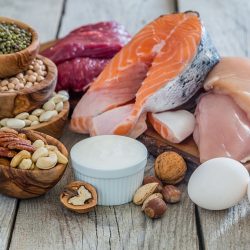Needs vary from one individual to another. Nutrients are used by the body to produce energy, make the basic building blocks of our cells and maintain chemical balances in the body. Gender, age, body type, genetic makeup and physical activity create different needs for each individual.
The requirements for a given nutrient or energy are defined as the amount necessary to maintain normal physiological functions and health and to cope with certain periods of life such as growth, gestation, lactation.
Recommended nutritional intake values:
The recommendations give values for the main categories of people, defined taking into account age, sex and physical activity.
Protein requirements:
Proteins are the building blocks of all cells in the body. Their essential role is to build the architecture of cells, to ensure their functioning and to allow muscle contractions. They have a structural, enzymatic, immunological, metabolic or hormonal role. They are particularly abundant in the muscles. Proteins make up 20% of body weight, but 75% of muscle weight.
Amino acids grouped into peptides, polypeptides or proteins by molecular weight are the building blocks of proteins. The nutritional value of a food depends not only on the amount of protein but also on the proportion of the different amino acids that constitute it. There are two kinds of amino acids in the human body, those that the body can synthesize (there are about a dozen) and those that the body cannot (there are about eight). Amino acids that the body cannot synthesize are called indispensable or essential amino acids.
The minimum protein requirement is around 0.8 g / kg / day. The protein ANCs per day in adults are 0.8 g / kg of good quality protein (ie at least 1/3 of animal protein). Between 2 and 18 years, they are in the order of 0.9 g / kg / day. In pregnant or breastfeeding women and in the elderly, they amount to 1.0 g / kg / day.
Proteins should represent about 10-12% of the total daily energy intake, of which 50% is of animal origin and 50% of plant origin.
Lipid requirements:
Lipids come essentially in two forms: triglycerides and phospholipids. Both are made up mostly of fatty acids. They also include other molecules like cholesterol.
They play an essential role in homeostasis by allowing it to be maintained both during periods of abundance, when they will be stored in the form of triglycerides (lipogenesis), and during fasting, where the reserves will be used (lipolysis). First of all, lipids have an energy role. Indeed, the energy reserve compartment is essentially constituted by the triglycerides of the white adipose tissue. In healthy adults of normal weight, this tissue makes up 12 to 25% of body weight, of which 75% is triglycerides. In total, 80 to 130,000 kcal are thus stored.
These energy reserves are called upon in times of prolonged energy deficiency. Fatty acids are energy substrates especially for skeletal muscles, heart muscle and liver. Lipids also have a structural role. They contribute to the membrane architecture. The lipid bilayer is essentially made up of complex lipids, 70 to 90% of which are represented by phospholipids.
Fatty acids therefore have an energetic, structural and functional role. They are classified according to their degree of unsaturation in saturated and unsaturated fatty acids (monounsaturated and polyunsaturated). Saturated fatty acids tend to promote cholesterol deposits in the arteries and increase the risk of cardiovascular disease, while unsaturated fatty acids tend to protect against cardiovascular disease.
The recommended intakes for lipids are 30 to 35% of the calorie intake (1/4 of saturated fatty acids, 1/2 of monounsaturated fatty acids, 1/4 of polyunsaturated fatty acids).
Carbohydrate requirements:
Carbohydrates are the main source of energy for our body. Mainly used by the brain and muscles, the carbohydrate reserves in the body are found to be limited. It is mainly found in the muscles and in the liver, in the form of glycogen. 80-90% of the energy provided by carbohydrates is absorbed in the form of glucose. It can be used by all cells in the body as a source of energy (the oxidation of one glucose molecule leads to the formation of 38 ATP molecules).
Glucose is the only source of energy for nerve cells and the lens of the eye under normal circumstances. Insulin promotes its penetration into cells. Carbohydrates also participate in the synthesis of certain molecules (RNA and DNA: ribose and deoxyribose) and in the purification of toxic products for the body.
Among dietary carbohydrates, depending on their structure, we can distinguish:
- Simple sugars that are quick and easy to digest including monosaccharides (glucose, fructose, galactose) and disaccharides (lactose, sucrose or maltose)
- Complex sugars or polysaccharides. Starches (amylose, amylopectin) are digestible, fibers are non-digestible
The minimum carbohydrate requirement is 150 g / d. The recommended intakes are 50 to 55% of the calorie intake (including 1/5 of simple sugars).
Dietary fiber requirements:
Fibers are polysaccharides (except lignin). There are two groups of fibers according to their chemical properties and their nutritional qualities. In the presence of water, after a swelling step, the fibers can either dissolve or remain insoluble.
- Soluble fibers:
These fibers, like pectins, gums or oligosaccharides, are found in fruits and vegetables. They have the ability to absorb a large amount of water and form a gel that thickens the contents of the stomach and delays its passage through the intestine by slowing the absorption of nutrients, especially carbohydrates and have a cholesterol lowering effect . They promote the balance of the intestinal flora.
- Insoluble fiber:
They stay suspended in the water and swell. These fibers, like cellulose and lignin, are found in grain products, and in leafy vegetables. They have a satietogenic role and a laxative effect. They also play a role in the prevention and relief of constipation and its consequences (hemorrhoids).
Vitamin requirements:
A vitamin is a substance essential for life, the deprivation of which leads to manifestations of deficiency, which may take longer or shorter to appear depending on the state of the body’s reserves, and which it must find in food. Vitamins do not have energy power. In this, they are different from the energy nutrients that are proteins, lipids and carbohydrates.
These are substances of organic origin: in this they are distinguished from trace elements and mineral salts, which living organisms must also find in their diet.
Finally, they are distinguished from hormones, which are also organic substances necessary for life in very small quantities, but which can be produced by the body, while vitamins are not (vitamin D is one of the few vitamins which is similar to a hormone because it is produced in the skin under the influence of ultraviolet rays from the sun).
A diversified and balanced diet normally covers vitamin needs. Vitamins, 13 in number, play an essential role in the proper functioning of the body. There are two categories of vitamins, the fat soluble, provided with the ingestion of fatty foods, and the water soluble. Regarding fat soluble vitamins, we find vitamins A, D, E and K. Water soluble vitamins are those of group B and C.
The needs in mineral salts and trace elements:
Mineral salts and trace elements are components of the body, of mineral origin. There is no well-established difference between mineral salts and trace elements, if not their content in the body.
Mineral salts exist in relatively high amounts in the body: these are calcium, sodium, magnesium, phosphorus and potassium.
Trace elements, on the contrary, are present in very small quantities in the body, and even, for some, in trace amounts: these are iron, zinc, fluorine, copper, iodine, manganese, cobalt, selenium, vanadium, molybdenum, chromium.
These elements of mineral origin are eliminated from the body on a regular basis, and their losses must, for this reason, be compensated by corresponding food intake. These are essential nutrients that provide zero calories.
The most important property to explain the role of these minerals is their extraordinary ability to bind to proteins, modifying by attaching the shape of these proteins and then changing their properties.





